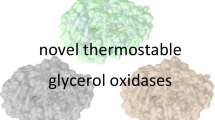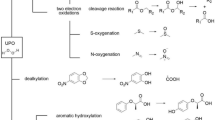Abstract
1,3-propanediol (1,3-PD) is an important material for chemical industry, and there has been always much interest in the production of 1,3-PD using all possible routes. The genes encoding glycerol dehydratase (GDHt) from Citrobacter freundii, Klebsiella pneumoniae and metagenome were cloned and expressed in E. coli. All glycerol dehydratases but the one from metagenome could be detected to show enzyme activities. In order to improve the enzymatic properties of GDHts, the genes encoding α and β-γ subunits were cloned, and the enzyme characteristics were evolved by rational design based on their 3D structures which were constructed by homology modeling. Six heteroenzymes were obtained by swapping the α subunit genes of these three different-source-derived GDHts. The pH, thermal stability and V max of some heteroenzymes were dramatically improved by 2–5 times compared with the wild one (GDHtKP). The GDHt cloned from metagenome, originally proved to be with no enzyme activity, was converted into active enzyme by swapping its subunits with other different GDHts. In addition, the effect of subtle 3D structural changes on the properties of the enzyme was also observed.
Similar content being viewed by others
References
Raynaud C, Sarcabal P, Meynial S I, et al. Molecular characterization of the 1,3-propanediol (1,3-PD) operon of Clostridium butyricum. Proc Natl Acad Sci USA, 2003, 100(9): 5010–5015
Papanikolaou S, Ruiz S P, Pariset B, et al. High production of 1,3-propanediol from industrial glycerol by a newly isolated Clostridium butyricum strain. J Biotechnol, 2000, 77(2–3): 191–208
Tong I T, Liao H H, Cameron D C. 1,3-Propanediol production by Escherichia coli expressing genes from the Klebsiella penumoniae dha regulon. Appl Environ Microbiol, 1991, 57(12): 3541–3546
Claisse O, Lonvaud F A. Primers and a specific DNA probe for detecting lactic acid bacteria producing 3-hydroxypropionaldehyde from glycerol in spoiled ciders. J Food Prot, 2001, 64(6): 833–837
Macis L, Daniel R, Gottschalk G. Properties and sequence of the coenzyme B12-dependent glycerol dehydratase of Clostridium pasteurianum. FEMS Microbiol Lett, 1998, 164: 21–28
Tobimatsu T, Azuma M, Matsubara H, et al. Cloning, sequencing, and high level expression of the genes encoding adenosylcobalamin-dependent glycerol dehydrase of Klebsiella pneumoniae. J Biol Chem, 1996, 271(37): 22352–22357
Wang W, Sun J, Hartlep M, et al. Combined use of proteomic analysis and enzyme activity assays for metabolic pathway analysis of glycerol fermentation by Klebsiella pneumoniae. Biotechnol Bioeng, 2003, 83(5): 525–536
Barbirato F, Larguier A, Conte T, et al. Sensitivity to pH, product inhibition, and inhibition by NAD+ of 1,3-propanediol dehydrogenase purified from Enterobacter agglomerans CNCM 1210. Arch Microbiol, 1997, 168: 160–163
Seyfried M, Daniel R, Gottschalk G. Cloning, sequencing, and overexpression of the genes encoding coenzyme B12-dependent glycerol dehydratase of Citrobacter freundii. J Bacteriol, 1996, 178(19): 5793–5796
Tobimatsu T, Azuma M, Matsubara H, et al. Cloning, sequencing, and high level expression of the genes encoding adenosylcobalamin-dependent glycerol dehydrase of Klebsiella pneumoniae. J Biol Chem, 1996, 271(37): 22352–22357
Zhang H Y, Kong X Z, Zhang J. New strategies of protein engineering-directed evolution of enzyme in vitro. Chin Sci Bull, 1999, 44(18): 1641–1648
Singh, A, Hayashi, K. Construction of chimeric beta-glucosidases with improved enzymatic properties. J Biol Chem, 1995, 270: 21928–31933
Knietsch A, Bowien S, Whited G, et al. Identification and characterization of coenzyme B12-dependent glycerol dehydratase-and diol dehydratase-encoding genes from metagenomic DNA libraries derived from enrichment cultures. Appl Environ Microbiol, 2003, 69: 3048–3060
Zhou J, Bruns M A, Tiedje J M. DNA recovery from soils of diverse composition. Appl Environ Microbiol, 1996, 62(2): 316–322
Schwede T, Kopp J, Guex N, et al. SWISS-MODEL: An automated protein homology-modeling server. Nucleic Acids Res, 2003, 31: 3381–3385
Qi X H, Zhu QX, Huang R B, et al. Gene cloning and expression of glycerol dehydratase from Citrobacter freundii in Escherichia coli. Ind Microbiol China (in Chinese), 2005, 35: 10–13
Minagawa H, Shimada J, Kaneko H. Effect of mutations at Glu160 and Val198 on the thermostability of lactate oxidase. Eur J Biochem, 2003, 270: 3628–3633
Knietsch A, Waschkowitz T, Bowien S, et al. Metagenomes of complex microbial consortia derived from different soils as sources for novel genes conferring formation of carbonyls from short-chain polyols on Escherichia coli. J Mol Microbiol Biotechnol, 2003, 5(1): 46–56
Cui Y, Ling L J, Chen RS, et al. Molecular dynamics simulation of site-directed mutagenesis of HIV-1 Tat trans-activator. Chin Sci Bull, 1999, 44(8): 708–711
Wang D C, Protein Engineering (in Chinese). Beijing: Chemical Industrial Press, 2002. 149–165
Tobimatsu T, Kajiura H, Toraya T. Specificities of reactivating factors for adenosylcobalamin-dependent diol dehydratase and glycerol dehydratase. Arch Microbiol, 2000, 174(1–2): 81–88
Liao D I, Dotson G, Turner I J, et al. Crystal structure of substrate free form of glycerol dehydratase. J Inorg Biochem, 2003, 93(1–2): 84–91
Dai L S, Ji C N, Wang J, et al. Modeling study of the thermostable alkaline phosphatase (FD-TAP). Chin J Biochem Mol Biol, 2001, 17(3): 365–371
Author information
Authors and Affiliations
Corresponding authors
About this article
Cite this article
Qi, X., Sun, L., Luo, Z. et al. Rational design of glycerol dehydratase: Swapping the genes encoding the subunits of glycerol dehydratase to improve enzymatic properties. CHINESE SCI BULL 51, 2977–2985 (2006). https://doi.org/10.1007/s11434-006-2219-5
Received:
Accepted:
Issue Date:
DOI: https://doi.org/10.1007/s11434-006-2219-5




